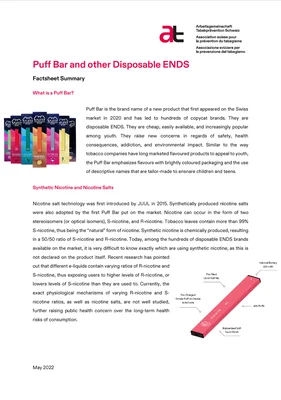Puff Bar and other Disposable ENDS
What is a Puff Bar?
Puff Bar is the brand name of a new product that first appeared on the Swiss market in 2020 and has led to hundreds of copycat brands. They are disposable ENDS. They are cheap, easily available, and increasingly popular among youth. They raise new concerns in regards of safety, health consequences, addiction, and environmental impact. Similar to the way tobacco companies have long marketed flavoured products to appeal to youth, the Puff Bar emphasizes flavours with brightly coloured packaging and the use of descriptive names that are tailor-made to ensnare children and teens.
Synthetic Nicotine and Nicotine Salts
Nicotine salt technology was first introduced by JUUL in 2015. Synthetically produced nicotine salts were also adopted by the first Puff Bar put on the market. Nicotine can occur in the form of two stereoisomers (or optical isomers), S-nicotine, and R-nicotine. Tobacco leaves contain more than 99% S-nicotine, thus being the “natural” form of nicotine. Synthetic nicotine is chemically produced, resulting in a 50/50 ratio of S-nicotine and R-nicotine. Today, among the hundreds of disposable ENDS brands available on the market, it is very difficult to know exactly which are using synthetic nicotine, as this is not declared on the product itself. Recent research has pointed out that different e-liquids contain varying ratios of R-nicotine and S-nicotine, thus exposing users to higher levels of R-nicotine, or lowers levels of S-nicotine than they are used to. Currently, the exact physiological mechanisms of varying R-nicotine and S-nicotine ratios, as well as nicotine salts, are not well studied, further raising public health concern over the long-term health risks of consumption.
Environmental Impact
Single-use, disposable e-cigarettes like the Puff Bar pose the biggest threat to the environment because, as the name suggests, they are used only once, and then discarded with their plastic exterior and lithiumion battery made of lithium, cobalt, and nickel. In addition to their batteries and plastics, they typically contain harmful chemicals which can in turn leak out into the environment and pose a biohazard risk.
Social Media Marketing and Influencers
The cheap and accessible nature of the Puff Bar highlights the ease with which children and teens can purchase them. In Switzerland, numerous online retailers sell the Puff Bar, with various copycats providing a range of sizes, from 150 to 5,500 puffs for the largest Puff Bar and prices from CHF 5.- to CHF 20.-. Various Swiss-based Instagram profiles have begun to appear as well, many of which promote Puff Bar sales. On YouTube, numerous channels of youth reviewing different Puff Bar products, particularly new more impressive ones, have become increasingly popular.
Puff Bar Regulation in the EU and Switzerland
Article 20 of the Tobacco Products Directive (2014/40/EU) lays down rules for electronic cigarettes sold as consumer products in the EU. The Directive sets various safety and quality requirements for e-cigarettes, such as a maximum nicotine concentration and volume for liquids. Moreover, mandatory health warnings must advise consumers that the products contain nicotine and should not be used by non-smokers. In April 2018, a ban on sales of e-cigarettes with nicotine was overturned by the Swiss Federal Administrative Court. No other federal rules have been implemented to prevent harm from e-cigarette use. So far, all ENDS can be purchased legally by minors in Switzerland. Only a few cantons adopted a sales ban. The new Federal Act on Tobacco Products, adopted by the Swiss Parliament on Oct. 1, 2021, will ban the sale of all tobacco and nicotine products to minors nationwide, but it will enter into force only in mid-2023. Until then, all ENDS may be sold in Switzerland, as long as they respect EU technical standards.
Downloads
AT Switzerland, March 2022

